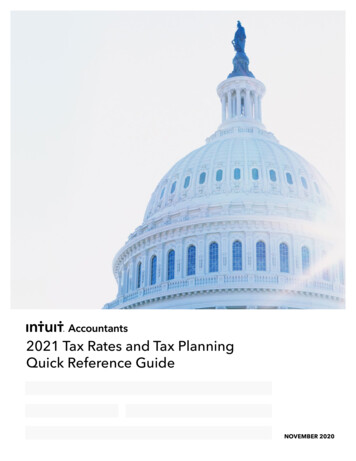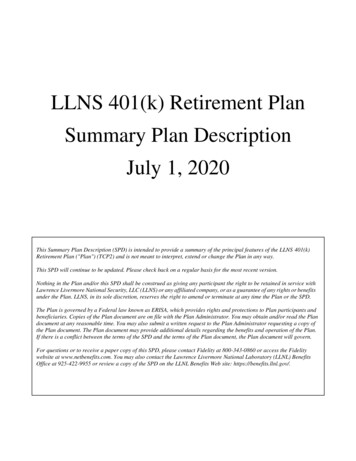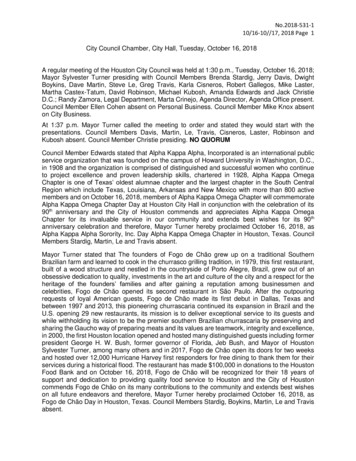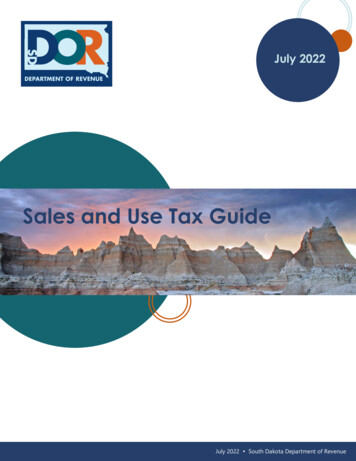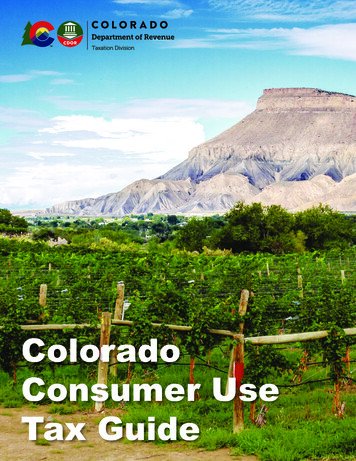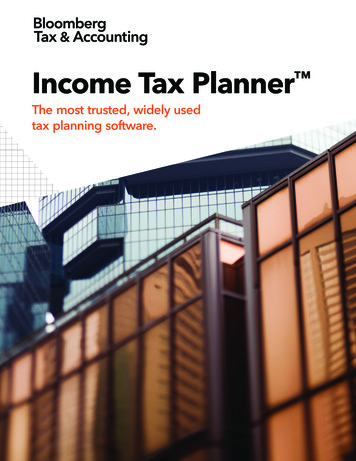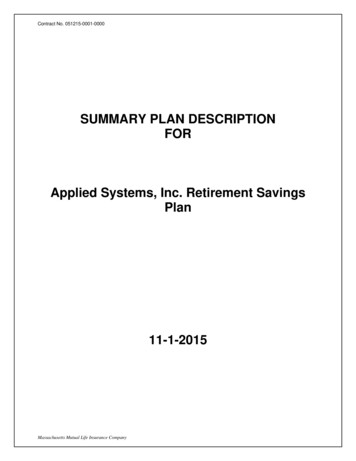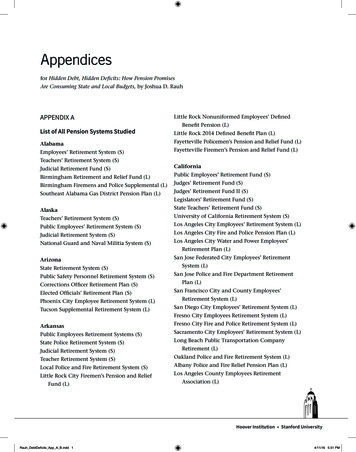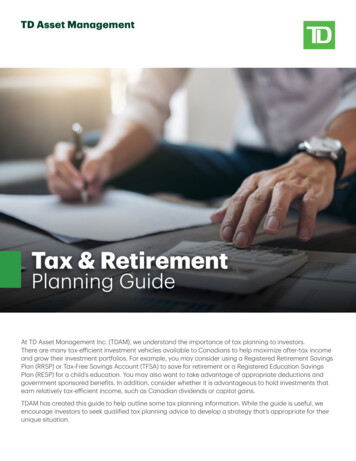
Transcription
Tax & RetirementPlanning GuideAt TD Asset Management Inc. (TDAM), we understand the importance of tax planning to investors.There are many tax-efficient investment vehicles available to Canadians to help maximize after-tax incomeand grow their investment portfolios. For example, you may consider using a Registered Retirement SavingsPlan (RRSP) or Tax-Free Savings Account (TFSA) to save for retirement or a Registered Education SavingsPlan (RESP) for a child’s education. You may also want to take advantage of appropriate deductions andgovernment sponsored benefits. In addition, consider whether it is advantageous to hold investments thatearn relatively tax-efficient income, such as Canadian dividends or capital gains.TDAM has created this guide to help outline some tax planning information. While the guide is useful, weencourage investors to seek qualified tax planning advice to develop a strategy that’s appropriate for theirunique situation.
Tax Planning2022 Federal Tax Brackets & Rates2022 Top Marginal Personal Tax Rates1Interestand RegularIncome %CapitalGains %EligibleCanadianDividends %Non-eligibleCanadianDividends 34.3142.30 155,626 – 221,70829.0%British Columbia53.5026.7536.5448.89 221,709 and over33.0%Manitoba50.4025.2037.7946.67New Brunswick53.3026.6533.5147.75Newfoundlandand Labrador54.8027.4046.2048.96Northwest Territories47.0523.5328.3336.82Nova 347.04Important Dates1:Québec53.3126.6540.1148.70 RSP Contribution Deadline:March 1, 2022Saskatchewan47.5023.7529.6441.82 Individual tax filing deadline:April 30, 2022Yukon48.0024.0028.9244.05 Payment date for 2021 taxes:April 30, 2022 for individualand self-employed returns.Non-Resident248.0024.0036.7240.80Taxable IncomeRateUp to 50,19715.0% 50,198 – 100,39220.5% 100,393 – 155,625Province/TerritorySource: Canada Revenue Agency (CRA).Payroll Deductions 20221area of interestMaximumEI Premium2Maximum CPPContribution3Top Federal Tax Rate2022Changefrom 2021 952.74 3,499.8033%Source: Canada Revenue Agency (CRA), Régie des rentesQuebec (RRQ). 1 Figures rounded to nearest dollar.2Maximum EI premium for employees outside of Quebec.The maximum for Quebec employees is 723.60 as atJanuary 1, 2022. 3 The maximum QPP contribution peremployee is 3,776.10 as at January 1, 2022. Self-employed tax filing deadline:June 15, 2022Source: Ernst & Young Combined Federal and Provincial Personal Income Tax Rates 2022, KPMGPersonal Tax Rates 2022, KPMG Tax Facts 2021-2022, Canada Revenue Agency (CRA), Régie desrentes Québec (RRQ). 1 The combined top marginal tax rate is the rate an individual will pay onincome that falls into the highest tax bracket in the province or territories of residence. 2 Non-residentrates for interest and dividends apply only in limited circumstances. Quarterly deadlines if you pay taxesto CRA by instalments:Tax-Free Savings Account (TFSA) Contribution Limits- March 15, 2022Tax FreeSavings Account- June 15, 2022- September 15, 2022AnnualContribution Limits1- December 15, 202212022 important dates are subject to change.2009 – 20122013 – 201420152016 – 20182019 – 2022 5,000 5,500 10,000 5,500 6,000The TFSA annual room limit will be indexed to inflation and rounded to the nearest 500.1If a deadline falls on a weekend or official holiday,a return is considered filed on time if it is sent onthe first business day after the filing deadline.Quebec returns do not observe an extensionfor weekends or holidays, therefore the returndeadline is April 30, 2022.Tax & Retirement Planning GuidePage 2
Tax PlanningTax-Free Savings Account (TFSA)1The key features are: Starting in 2009, Canadian residents aged 18 and older could contribute into a TFSA. Contributions to a TFSA are not deductible for income tax purposes, but investment income, including interest,dividends and capital gains earned in a TFSA are not taxed. Unused TFSA contribution room can be carried forward to future years. You can withdraw funds from the TFSA at any time for any purpose.2 You cannot contribute more than your TFSA contribution room in a given year, even if you made withdrawals duringthat year. However, amounts withdrawn in one year are added to your TFSA contribution room in the followingcalendar year. If, at any time in a month, you have an excess TFSA amount (which is, generally, an over-contribution to your TFSA),you are liable for a tax of 1% on the highest excess TFSA amount in that month.12Source: Department of Finance Canada.Some restrictions may apply, depending on the investments chosen.Retirement PlanningRetirement Savings Plan (RSP) Contribution LimitsWithholding Tax Rates for RSP/RIF Withdrawals18% of Previous Year’s Earned Income to a Maximum of:Amount Withdrawnin Excess of Minimum2YearMaximum RSP Contribution2016 25,3702017 26,0102018 26,2302019 26,5002020 27,2302021 27,8302022 29,210All ProvincesExcept QuebecQuebecNonResidents1Up to 5,00010%5% federal 15% provincial25% 5,001 to 15,00020%10% federal 15% provincial25%Over 15,00030%15% federal 15% provincial25%For non-residents of Canada, withholding tax is 25% unless reduced by atreaty. 2 This amount refers to the required annual minimum withdrawals,specifically from a RIF.1Source: Canada Revenue Agency (CRA).Withdrawal Programsarea of interestRSP Home Buyers’ Plan (HBP)1RSP Lifelong Learning Plan (LLP)1EligibilityMust be considered a “First-time Home Buyer2”:Cannot have lived in a home owned by the annuitantor the annuitant’s spouse or common-law partnerduring the period between January 1 of the fourthyear before the year of withdrawal, and the 31st daybefore the withdrawal. Other conditions apply. Formore information please visit the Canada RevenueAgency website at www.canada.ca/en/revenueagency.html.The annuitant or the annuitant's spouse or common-law partnermust be enrolled full-time (part-time for students meeting one ofthe disability conditions) in a qualifying educational program orhave a written offer to enrol at a designated educational institutionbefore March 1 of the year following the year of first withdrawal. Theprogram must be of at least three consecutive months' duration with10 hours of weekly course work. Other conditions apply. For moreinformation please visit the Canada Revenue Agency website atwww.canada.ca/en/revenue-agency.html.Limits 35,000 per participant. 10,000 per year to a maximum of 20,000 over four years.Repayment3Generally, 1/15th per year beginning the second yearfollowing the year of withdrawal, payable by 60 daysinto the following year.Generally, 1/10th per year, with the first repayment due 60 daysafter the fifth year following the first withdrawal. Repayments maycommence in the second year following the withdrawal, if thecourse is completed in the year of withdrawal. For complete details,please visit www.canada.ca/en/revenue-agency.html.Source: CRA. 2 Unless you are a person with a disability or you are helping a related person with a disability buy or build a qualifying home. 3 Any amountthat is not repaid will be added to taxable income for the year the repayment is due. You have up to 15 years to repay the Home Buyers Plan and up to 10years to repay the Lifelong Learning Plan.1Tax & Retirement Planning GuidePage 3
Retirement PlanningPayment Rates - Canada Pension Plan (CPP) & Quebec Pension Plan (QPP)CPP MaximumMonthly Benefit(2022)QPP MaximumMonthly Benefit(2022)Retirement Pension (At Age 65) 1,253.59 1,253.59Disability Benefit (Under Age 65) 1,464.83Survivor's Benefit (Under Age 65)Type of BenefitRetirement Income Fund (RIF)Annual Minimum Withdrawals (%)(Fair market value of RIF on December 31multiplied by prescribed factors below)1Age22017 Factor 1,463.83715.28 674.79 993.101725.40Survivor's Benefit (Age 65 and Over) 752.15 746.65735.53745.67Children of Disabled Contributor Benefit 264.53 83.99755.82Children of Deceased ContributorsBenefit 264.53 264.53765.98Combined Survivor's and RetirementBenefit (Retirement At Age 65)776.17 1,257.13 1,258.49786.36Combined Survivors and DisabilityBenefit 1,467.04See footnote2796.58Death Benefit (Max Lump Sum) 2,500.00 879.55Source: Government of Canada from January 2022 to December 2022, Government of CanadaQuarterly Report of CPP and OAS monthly amounts from January to March 2022, Régie des rentesQuebec (RRQ). 1 Between 45 - 64 years of age. 2 Please contact RRQ for more information.Old Age Security Benefit Payment RatesType of BenefitOld Age Security(OAS) Pension41RecipientMaximumMonthly BenefitAll Recipients 642.25Single PersonMaximumAnnual Income2 133,1403(see Old AgeSecurity below)8810.21 959.263 19,4638910.99Spouse of Pensioner 577.43 25,72749011.92Spouse ofNon-Pensioner 959.26 46,65549113.06Spouse ofAllowance Recipient9214.49 577.43 46,6559316.34AllowanceAll Recipients 1,219.68 36,04749418.79Allowance ForThe Survivor95 20All Recipients 1,453.93 26,257GuaranteedIncomeSupplement (GIS)43Source: Government of Canada January 2022 to March 2022. 1 For eligible recipients aged 65 orover. OAS benefits are reviewed quarterly and generally indexed to CPI. 2 The income level cut-offsdo not include the OAS pension or the first 5,000 of employment income. 3 Individual income.4Combined income. Eligible recipients aged 75 and over will see an automatic 10% increase of theirOAS pension as of July 2022.For annuitants under the age of 71, the factor is basedon the following formula: 1/ (90 - annuitant's or spouse'sage). Minimum withdrawal in the year in which the RIF isestablished is nil. 2 Age is as of the start of the year.1Old Age Security Clawback If your net income before adjustments exceeds 81,761, part or the entire OAS pension amount may need to be repaid. The repayment amount is equal to 15% of the amount an individual’s net income exceeds the threshold ( 81,761), up tothe full OAS payment. The OAS recovery tax is normally deducted on a monthly basis as installments or pre-payments of expected OASclawback based off of the previous year's tax return. The full OAS payment is eliminated when a pensioner’s net income is 133,141 or above.Tax & Retirement Planning GuidePage 4
Education PlanningRegistered Education Savings Plan (RESP)area of interestDetailsContributionMaximumThere is no annual limit for contributions to RESPs. For each beneficiary, the lifetime contribution limit to an RESP is 50,000.ContributionAge LimitContributions can be made until December 31 of the 31st year following the year the plan is entered into.Family plan only: final contribution must be made before the beneficiary's 31st birthday.Plan Age LimitRESP must be collapsed before December 31 of the 35th year following the year the plan is entered into.Penalty OnOver-Contribution1% per month of the over-contribution amount outstanding at the end of the month.Basic CanadaEducationSavings Grant(CESG)20% on annual contributions made to all eligible RESPs for a qualifying beneficiary, to an annual maximum of 500 ( 1,000 where there is unused grant room from a previous year). Additional contribution requirements applyto beneficiaries who are 16 or 17. Unused CESG grant room may be carried forward for possible use in the future.Lifetime maximum CESG amount per beneficiary is 7,200. Please refer to CRA website for more information.AdditionalCESG1,2Family income up to 50,197: additional CESG on the first 500 in annual RESP contributions is 20%.Family income between 50,198 and 100,392: additional CESG on the first 500 in annual RESP contributions is 10%.Canada LearningBond (CLB) 1,2Provides 500 at first year of eligibility and 100 annually (to a maximum of 2000) until age 15 for children bornafter 2003 to families who meet certain income criteria (paid only in the years when the family’s income qualifies).Quebec EducationSavings Incentive(QESI)1,310% on the first 2,500 of annual contributions (with greater support for families that qualify based on lowerincome) up to a lifetime limit of 3,600 per child. The child must be named as a beneficiary of an RESP, be aresident of Quebec at the end of the year, and meet other eligibility requirements.British ColumbiaTraining andEducationSavings Grant(BCTESG)1 1,200 one-time grant to eligible beneficiaries born on or after January 1, 2006. The last day to apply is theday before the beneficiary turns 9 years old. The child must be a resident of British Columbia at the time of theapplication, and meet other eligibility WithdrawalsEducational Assistance Payment (EAP): CESG, CLB, amounts paid under a provincial education savings program,and the earnings on the money saved in the RESP. These are paid to the beneficiary and taxable as earned incomefor the beneficiary in the year that they are received.Post-Secondary Educational (PSE) Contribution Withdrawal: Payable to subscriber who may gift it to beneficiary orretain it for him/herself with no tax payable.Accumulated Income Payment (AIP): Subject to certain conditions (including the repayment of grants), incomeearned in the plan is payable to the subscriber who may be able to transfer the amount to his/her RRSP (subject toavailability of RRSP contribution room). If taken as cash, the AIP amount is taxable based on subscriber’s marginaltax rate plus an additional 20% penalty tax. Alternatively, such amounts may be paid (gifted) to a designatededucational institution in Canada.Refund of Contributions (ROC) If a beneficiary is not eligible for an EAP, the withdrawal of contributions is nottaxable, but generally trigger CESG repayments and could require the repayment of certain provincial grants.Source: CanLearn and Employment and Social Development Canada (ESDC). 1 The TD Mutual Funds Education Savings Plan supports only the basic CanadaEducation Savings Grant and not any other provincial or federal government RESP grants or tax incentives. 2 Effective January 2005. 3 Effective February 2007.4Effective January 2013.Tax & Retirement Planning GuidePage 5
Consumer Price Index (CPI)YearConsumer Price Index (CPI)CPI% ChangeYearCPI% Change1951 – 1960–12.32009114.40.31961 – 1970–29.32010116.51.81971 – 1980–110.52011119.92.91981 – 1990–58.42012121.71.51991 – 211444.8Source: Statistics Canada. Base year: 2002 100.0. As of December 31, 2021.How to Manage Personal Tax Info and More OnlineThe CRA offers secure access to personal tax information through their website service called “My Account”.It includes information about tax refunds or balance owing, RRSP, Home Buyers' Plan, Lifelong Learning Plan,Tax-Free Savings Account and more. Visit www.canada.ca/en/revenue-agency.html for more information.For more information, please contact your investment professional.Connect with TD Asset ManagementAll information contained in this document was updated based on availability of data as of December 31, 2021. The information contained herein has beenprovided by TD Asset Management Inc. and is for information purposes only. The information has been drawn from sources believed to be reliable. Graphsand charts are used for illustrative purposes only and do not reflect future values or future performance of any investment. The information does not providefinancial, legal, tax or investment advice. Particular investment, tax, or trading strategies should be evaluated relative to each individual's objectives andrisk tolerance. TD Asset Management Inc. is a wholly-owned subsidiary of The Toronto-Dominion Bank. All trademarks are the property of their respectiveowners. The TD logo and other trademarks are the property of The Toronto-Dominion Bank or its subsidiaries.(0222)
Tax & Retirement Planning Guide Page 4 Retirement Planning Payment Rates - Canada Pension Plan (CPP) & Quebec Pension Plan (QPP) Type of Benefit CPP Maximum Monthly Benefit (2022) QPP Maximum Monthly Benefit (2022) Survivor's Benefit (Under Age 65) 674.79 993.101 Survivor's Benefit (Age 65 and Over) 752.15 746.65
